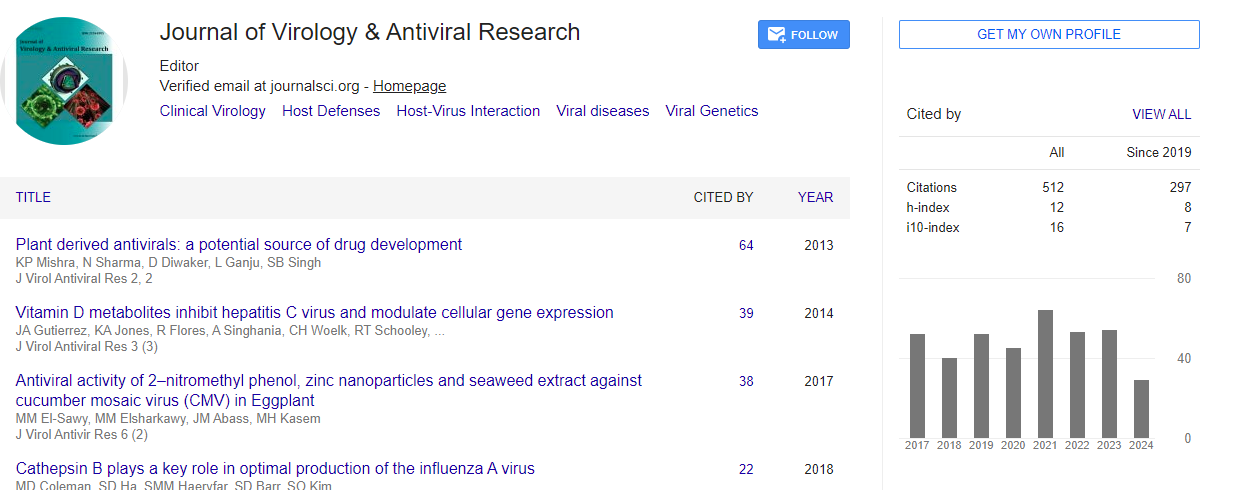Opinion Article, J Virol Antivir Res Vol: 13 Issue: 1
Antiretroviral Therapy: Past, Present, and Future Perspectives in Managing HIV Infection
Maira Duarte*
1Department of Pharmaceutical Sciences, Federal University of Pernambuco, Campus Recife, Pernambuco, Brazil
*Corresponding Author: Maira Duarte,
Department of Pharmaceutical
Sciences, Federal University of Pernambuco, Pernambuco, Brazil
E-mail: mairaduarte@gmail.com
Received date: 26 February, 2024, Manuscript No. JVA-24-136878;
Editor assigned date: 28 February, 2024, PreQC No JVA-24-136878 (PQ);
Reviewed date: 14 March, 2024, QC No. JVA-24-136878;
Revised date: 22 March, 2024, Manuscript No JVA-24-136878 (R);
Published date: 28 March, 2024, DOI: 10.4172/ 2324-8955.1000688
Citation: Duarte M (2024) Antiretroviral Therapy: Past, Present, and Future Perspectives in Managing HIV Infection. J Virol Antivir Res 13:1.
Description
Antiretroviral Therapy (ART) revolutionized the management of Human Immunodeficiency Virus (HIV) infection, transforming it from a fatal disease to a manageable chronic condition. This study provides a comprehensive overview of antiretroviral, including their historical development, mechanisms of action, resistance patterns, clinical efficacy, and challenges. We explore the evolution of antiretroviral drug classes, from the early Nucleoside Reverse Transcriptase Inhibitors (NRTIs) to the latest Integrase Inhibitors (INSTIs) and entry inhibitors. Additionally, we discuss emerging trends in HIV treatment, including long-acting formulations, novel drug combinations, and strategies for addressing persistent challenges such as drug resistance and treatment access. Through a multidisciplinary approach, we aim to provide insights into the past, present, and future of antiretroviral therapy in the fight against HIV/AIDS.
The introduction of Antiretroviral Therapy (ART) in the mid-1990s marked a paradigm shift in the management of HIV infection, leading to dramatic reductions in morbidity and mortality among people living with HIV/AIDS. Antiretroviral target different stages of the HIV replication cycle, inhibiting viral replication and preserving immune function. Over the past few decades, significant progress has been made in the development of antiretroviral drugs, resulting in improved treatment outcomes, simplified regimens, and enhanced patient adherence.
In this comprehensive overview of antiretroviral, highlighting their historical evolution, mechanisms of action, clinical efficacy, and challenges. We discuss the emergence of drug resistance, the evolution of combination therapy, and recent advancements in HIV treatment, including long-acting formulations and novel drug combinations. By examining the past, present, and future of antiretroviral therapy, we aim to contribute to ongoing efforts to optimize HIV treatment strategies and improve patient outcomes. The development of antiretroviral drugs began in the early days of the HIV epidemic, driven by the urgent need for effective treatments. The first class of antiretroviral to be approved for clinical use was the Nucleoside Reverse Transcriptase Inhibitors (NRTIs), which inhibit the activity of the viral enzyme reverse transcriptase, thereby blocking viral replication. Zidovudine (AZT) was the first NRTI to be approved by the FDA in 1987, followed by other agents such as Didanosine (DDI), zalcitabine (DDC), and Stavudine (d4T).
Subsequent years saw the development of additional classes of antiretroviral drugs, including Non-Nucleoside Reverse Transcriptase Inhibitors (NNRTIs), Protease Inhibitors (PIs), and fusion/entry inhibitors. NNRTIs such as efavirenz and nevirapine act by binding to the reverse transcriptase enzyme and inhibiting its activity through a non-competitive mechanism. PIs, exemplified by drugs like ritonavir and lopinavir, block the activity of the HIV protease enzyme, preventing the cleavage of viral polyproteins and the production of mature infectious virions. The advent of Combination AntiRetroviral Therapy (CART), also known as Highly Active AntiRetroviral Therapy (HAART), represented a major breakthrough in HIV treatment. By combining drugs with different mechanisms of action, CART suppresses viral replication more effectively, reduces the risk of drug resistance, and preserves immune function. The standard of care for HIV treatment shifted towards CART regimens consisting of two NRTIs plus either an NNRTI, a PI, or an Integrase Strand Transfer Inhibitor (INSTI).
Antiretroviral exert their effects by targeting key steps in the HIV replication cycle, disrupting viral replication and propagation. NRTIs and NNRTIs inhibit reverse transcriptase activity, preventing the conversion of viral RNA into DNA and subsequent integration into the host genome. PIs block the activity of the HIV protease enzyme, interfering with viral maturation and the production of infectious virions. Entry inhibitors such as maraviroc and enfuvirtide prevent viral entry into target cells by targeting the viral envelope glycoproteins or cellular co-receptors. Despite the efficacy of antiretroviral therapy, the emergence of drug resistance remains a significant challenge in the management of HIV infection. Resistance can develop through various mechanisms, including mutations in the viral genome that confer reduced susceptibility to antiretroviral drugs, poor adherence to treatment regimens, and suboptimal drug levels in target tissues. Resistance mutations can arise rapidly, particularly in the context of incomplete viral suppression or suboptimal drug concentrations.
Antiretroviral therapy has transformed HIV infection from a lifethreatening illness to a chronic, manageable condition, allowing people living with HIV/AIDS to achieve durable viral suppression and lead productive lives. Clinical trials have demonstrated the efficacy of CART in reducing HIV-associated morbidity and mortality, improving immune function, and preventing transmission of the virus to uninfected individuals. However, several challenges remain in the long-term management of HIV infection. Adherence to antiretroviral therapy is essential for achieving and maintaining viral suppression, yet many patients struggle with medication adherence due to factors such as pill burden, side effects, stigma, and socioeconomic barriers. Moreover, the development of drug resistance poses a constant threat to the effectiveness of antiretroviral therapy, necessitating regular monitoring of viral load and genotypic resistance testing.
 Spanish
Spanish  Chinese
Chinese  Russian
Russian  German
German  French
French  Japanese
Japanese  Portuguese
Portuguese  Hindi
Hindi 

